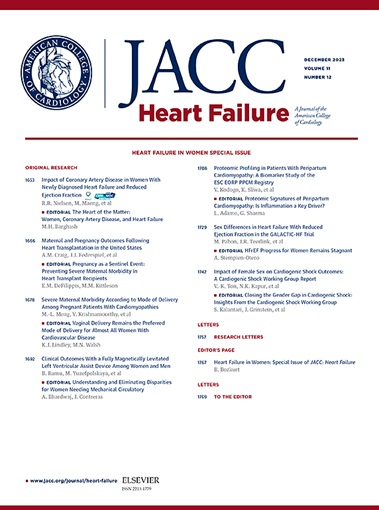心脏磁共振成像与冠状动脉造影作为新诊断心力衰竭的主要策略
IF 10.3
1区 医学
Q1 CARDIAC & CARDIOVASCULAR SYSTEMS
引用次数: 0
摘要
背景:新发心力衰竭伴射血分数降低(HFrEF)需要进一步的诊断评估以确定其潜在原因。尽管心脏磁共振(CMR)成像具有识别缺血性和非缺血性病因的潜力,但经皮侵入性冠状动脉造影(CATH)仍然是诊断缺血性心肌病(ICM)的首选工具。本研究旨在确定cmr优先策略是否可以像CATH一样有效地诊断ICM(主要终点),并可能减少侵入性手术的数量(次要终点)。方法在这项多中心双臂诊断试验(磁共振成像与侵入性冠状动脉造影作为新发心力衰竭的一线诊断方式)中,229例新发HFrEF患者随机分为两组,第一组接受CMR或CATH,第二组接受其他方式。独立的专家小组对两种方式进行评估,对彼此的结果一无所知。负责的心脏病专家对小组结果不知情,并作为参考标准。结果203例患者(平均年龄:62±14岁,女性28%)具有可评估的诊断方式对(108例cat -first)。对于ICM的诊断,专家组认为CATH的100%(105/105)和CMR的80%(76/95)是足够的;P & lt;0.001)。与对照比较,两组诊断ICM的敏感性均较高(CATH 91%, CMR 90%;P = 1.00),但CMR特异性较低(98% vs 74%;P & lt;0.001)。根据CMR专家组的数据,采用CMR优先策略可以避免48%(46/95)的CATH手术,当排除接受冠状动脉介入治疗的患者时,这一比例降至45%。结论尽管CATH在诊断ICM方面优于CMR,但CMR表现出相似的敏感性,可以显著减少CATH手术,而不会增加错过关键冠状动脉介入治疗的风险。需要进行纵向研究来评估cmr优先策略是否能带来预后益处。磁共振成像与有创冠状动脉造影作为新发心力衰竭的一线诊断方式;ISRCTN16515058)本文章由计算机程序翻译,如有差异,请以英文原文为准。
Cardiac Magnetic Resonance Imaging vs Coronary Angiography as Primary Strategy in Newly Diagnosed Heart Failure
Background
New-onset heart failure with reduced ejection fraction (HFrEF) requires further diagnostic evaluation to determine its underlying cause. Despite the potential of cardiac magnetic resonance (CMR) imaging to identify ischemic and nonischemic causes, percutaneous invasive coronary angiography (CATH) remains the preferred tool for diagnosing ischemic cardiomyopathy (ICM).
Objectives
This study aimed to determine whether a CMR-first strategy could diagnose ICM as effectively as CATH (primary endpoint) and potentially reduce the number of invasive procedures (secondary endpoint).
Methods
In this multicenter 2-armed diagnostic trial (Magnetic Resonance Imaging vs Invasive Coronary Angiography as First-Line Diagnostic Modality in New-Onset Heart Failure), 229 adults with new-onset HFrEF were randomized to undergo CMR or CATH first and the other modality second. Separate expert panels evaluated both modalities, blinded to each other’s results. The cardiologist-in-charge was blinded to the panel results and served as the reference standard.
Results
A total of 203 patients (mean age: 62 ± 14 years, 28% women) had evaluable pairs of diagnostic modalities (108 CATH-first). For diagnosing ICM, the panels considered CATH to be sufficient in 100% (105/105) and CMR in 80% (76/95; P < 0.001). Compared with the reference, sensitivity for diagnosing ICM was high for both (CATH 91%, CMR 90%; P = 1.00), but CMR had lower specificity (98% vs 74%; P < 0.001). According to the CMR panel, 48% (46/95) of CATH procedures could have been avoided with a CMR-first strategy, dropping to 45% when excluding patients who underwent coronary interventions.
Conclusions
Although CATH was superior for diagnosing ICM, CMR showed similar sensitivity and could significantly reduce CATH procedures without increasing the risk of missing critical coronary interventions. Longitudinal studies are needed to assess whether a CMR-first strategy confers prognostic benefit. (Magnetic Resonance Imaging vs Invasive Coronary Angiography as First-Line Diagnostic Modality in New-Onset Heart Failure; ISRCTN16515058)
求助全文
通过发布文献求助,成功后即可免费获取论文全文。
去求助
来源期刊

JACC. Heart failure
CARDIAC & CARDIOVASCULAR SYSTEMS-
CiteScore
21.20
自引率
2.30%
发文量
164
期刊介绍:
JACC: Heart Failure publishes crucial findings on the pathophysiology, diagnosis, treatment, and care of heart failure patients. The goal is to enhance understanding through timely scientific communication on disease, clinical trials, outcomes, and therapeutic advances. The Journal fosters interdisciplinary connections with neuroscience, pulmonary medicine, nephrology, electrophysiology, and surgery related to heart failure. It also covers articles on pharmacogenetics, biomarkers, and metabolomics.
 求助内容:
求助内容: 应助结果提醒方式:
应助结果提醒方式:


